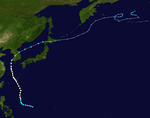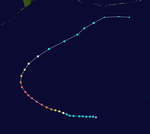Typhoon season in the Pacific Ocean
1952 Pacific typhoon season Season summary map
First system formed May 5, 1952 Last system dissipated January 4, 1953(record latest) Name Wilma • Maximum winds 295 km/h (185 mph)1-minute sustained ) • Lowest pressure 893 hPa (mbar )
Total storms 29 Typhoons 20 Super typhoons 6 (unofficial) Total fatalities 1,070 Total damage Unknown
Pacific typhoon seasons 1950 , 1951 , 1952 , 1953 , 1954
The 1952 Pacific typhoon season had no official bounds, but most tropical cyclones tend to form in the northwestern Pacific Ocean between June and December. These dates conventionally delimit the period of each year when most tropical cyclones form in the northwestern Pacific Ocean.
The scope of this article is limited to the Pacific Ocean, north of the equator and west of the international date line . Storms that form east of the date line and north of the equator are called hurricanes; see 1952 Pacific hurricane season . Tropical Storms formed in the entire west Pacific basin were assigned a name by the Fleet Weather Center on Guam .
Season summary [ ] Systems [ ] Typhoon Charlotte [ ] Duration June 10 – June 15 Peak intensity 155 km/h (100 mph) (1-min) 960 hPa (mbar )
Typhoon Charlotte formed on June 10, near the Philippines . It then strengthened and made landfall as a minimal typhoon near Hong Kong before dissipating on June 15.
Typhoon Dinah [ ] Duration June 19 – June 25 Peak intensity 140 km/h (85 mph) (1-min) 960 hPa (mbar )
On June 23, Dinah struck to the west of the Kanto Region in Japan. 65 people were killed and 70 were missing.[1]
Typhoon Emma [ ] Duration June 28 – July 6 Peak intensity 205 km/h (125 mph) (1-min) 975 hPa (mbar )
Typhoon Emma hit the Philippines and South China, especially Hainan Island.
Tropical Storm Freda [ ] Duration July 11 – July 15 Peak intensity 85 km/h (50 mph) (1-min) 995 hPa (mbar )
Freda weakened to a tropical depression before hitting Kyushu .
Tropical Storm Gilda [ ] Duration July 15 – July 20 Peak intensity 95 km/h (60 mph) (1-min) 990 hPa (mbar )
Tropical Storm Gilda hit China as a tropical storm.
Typhoon Harriet [ ] Duration July 26 – July 30 Peak intensity 185 km/h (115 mph) (1-min) 980 hPa (mbar )
Harriet hit China as a Category 3 typhoon, with winds of 115 mph (185 km/h).
Tropical Storm Ivy [ ] Duration August 2 – August 8 Peak intensity 85 km/h (50 mph) (1-min) 990 hPa (mbar )
This section is empty. You can help by . (April 2021 )
Tropical Storm Jeanne [ ] Duration August 4 – August 7 Peak intensity 75 km/h (45 mph) (1-min) 985 hPa (mbar )
This section is empty. You can help by . (April 2021 )
Typhoon Karen [ ] Duration August 10 – August 20 Peak intensity 155 km/h (100 mph) (1-min) 955 hPa (mbar )
Typhoon Karen struck land, mostly Korea and Japan.
Typhoon Lois [ ] Duration August 22 – August 30 Peak intensity 140 km/h (85 mph) (1-min) 975 hPa (mbar )
This section is empty. You can help by . (April 2021 )
Typhoon Mary [ ] Duration August 29 – September 4 Peak intensity 120 km/h (75 mph) (1-min) 985 hPa (mbar )
This section is empty. You can help by . (April 2021 )
Typhoon Nona [ ] Duration September 2 – September 8 Peak intensity 150 km/h (90 mph) (1-min) 980 hPa (mbar )
This section is empty. You can help by . (April 2021 )
Tropical Storm 12W [ ] Duration September 7 – September 14 Peak intensity 75 km/h (45 mph) (1-min) 995 hPa (mbar )
This section is empty. You can help by . (April 2021 )
Typhoon Olive [ ] Duration September 13 – September 21 Peak intensity 295 km/h (185 mph) (1-min) 940 hPa (mbar )
This section is empty. You can help by . (April 2021 )
Tropical Storm 14W [ ] Duration September 16 – September 19 Peak intensity 65 km/h (40 mph) (1-min) 996 hPa (mbar )
This section is empty. You can help by . (April 2021 )
Typhoon Polly [ ] Duration September 26 – October 3 Peak intensity 130 km/h (80 mph) (1-min) 975 hPa (mbar )
This section is empty. You can help by . (April 2021 )
Typhoon Rose [ ] Duration October 4 – October 10 Peak intensity 150 km/h (90 mph) (1-min) 985 hPa (mbar )
This section is empty. You can help by . (April 2021 )
Tropical Storm Shirley [ ] Duration October 14 – October 15 Peak intensity 75 km/h (45 mph) (1-min) 995 hPa (mbar )
Shirley tracked through Vietnam. Shirley weakened to a tropical depression before hitting Vietnam.
Typhoon Trix [ ] Duration October 15 – October 26 Peak intensity 220 km/h (140 mph) (1-min) 965 hPa (mbar )
This section needs expansion . You can help by . (April 2021 )
Typhoon Trix struck the Philippines as a Category 3 typhoon. It struck the Bicol region , killing 995 people.[2]
Typhoon Vae [ ] Duration October 17 – October 20 Peak intensity 120 km/h (75 mph) (1-min) 974 hPa (mbar )
This section does not cite any sources . Please help by adding citations to reliable sources . Unsourced material may be challenged and removed . (April 2021 ) (Learn how and when to remove this template message )
After striking Vietnam, Vae crossed over to the North Indian Ocean before dissipating.
Typhoon Wilma [ ] Duration October 21 – October 31 Peak intensity 295 km/h (185 mph) (1-min) 893 hPa (mbar )
This section needs expansion . You can help by . (April 2021 )
On October 26, ten people were lost when a USAF WB-29 disappeared during a flight into Super Typhoon Wilma.[3]
Typhoon Agnes [ ] Duration October 28 – November 7 Peak intensity 280 km/h (175 mph) (1-min) 920 hPa (mbar )
This section is empty. You can help by . (December 2021 )
Typhoon Bess [ ] Duration November 9 – November 16 Peak intensity 185 km/h (115 mph) (1-min) 915 hPa (mbar )
This section is empty. You can help by . (April 2021 )
Typhoon Carmen [ ] Duration November 15 – November 22 Peak intensity 205 km/h (125 mph) (1-min) 950 hPa (mbar )
This section is empty. You can help by . (April 2021 )
Typhoon Della [ ] Duration November 22 – November 27 Peak intensity 280 km/h (175 mph) (1-min) 980 hPa (mbar )
This section is empty. You can help by . (April 2021 )
Tropical Storm Elaine [ ] Duration December 4 – December 6 Peak intensity 85 km/h (50 mph) (1-min) 990 hPa (mbar )
This section is empty. You can help by . (April 2021 )
Tropical Storm Faye [ ] Duration December 16 – December 19 Peak intensity 85 km/h (50 mph) (1-min) 990 hPa (mbar )
This section is empty. You can help by . (April 2021 )
Typhoon Gloria [ ] Duration December 16 – December 25 Peak intensity 240 km/h (150 mph) (1-min) 990 hPa (mbar )
This section is empty. You can help by . (April 2021 )
Typhoon Hester [ ] Duration December 27 – January 4 Peak intensity 295 km/h (185 mph) (1-min) 950 hPa (mbar )
This section is empty. You can help by . (April 2021 )
Storm names [ ]
Charlotte
Dinah Emma
Freda
Gilda
Harriet
Ivy
Jeanne
Karen
Lois
Mary
Nona
Olive Polly
Rose
Shirley
Trix
Vae
Wilma
Agnes
Bess
Carmen
Della
Elaine
Faye
Gloria
Hester
See also [ ]
Tropical cyclones portal
References [ ]





































